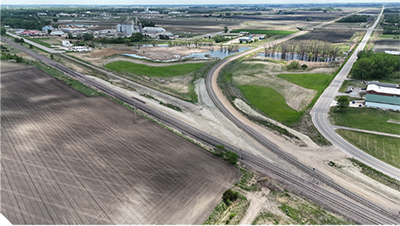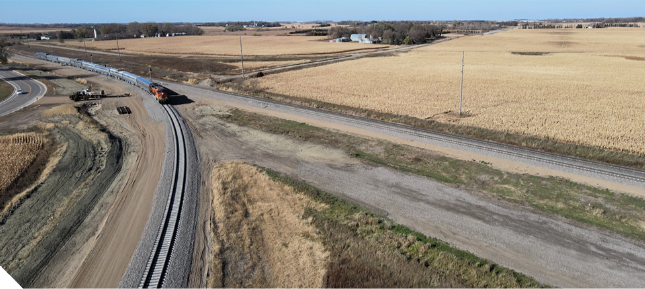Willmar Rail Project Clears Tracks for Growth, Reduces Downtown Congestion
By Deborah Lynn Blumberg

For years, Willmar residents sat in traffic waiting for freight trains to roll through town. Some mornings, as many as 10 rumbled into downtown, often stopping for long stretches at the city’s rail yard along the edge of a busy residential and business district — delaying commuters on their way to work. At night, train horns roused residents from their sleep.
With so many crossings, the trains also posed a safety concern for the community. City officials knew they needed to address quality-of-life concerns and rethink how local rail lines operated. A rail redevelopment plan aimed at making transport through Willmar more efficient also held the promise of attracting new industry. After years of lobbying for funding in Washington D.C., Willmar and its public and private partners, launched in 2019 an ambitious rail redevelopment project involving public-private partnerships and millions in federal funding.
Connecting rail subdivisions, diverting traffic
The Willmar Rail Connector and Industrial Park Access Project rerouted most freight trains away from the city’s downtown by building a direct connection between two Burlington Northern Santa Fe Railway (BNSF) rail network subdivisions that pass-through Willmar — the Marshall and Morris subdivisions. The initiative also provided freight rail access to Willmar’s Industrial Park and modified surrounding roadways to better support freight movement.
The massive project was led by a collaboration between the Minnesota Department of Transportation (MnDOT), BNSF, Willmar, Kandiyohi County, and the Kandiyohi County and Willmar economic development commissions. Six years later, efforts have not only alleviated some of the train traffic in Willmar, but have also started to attract private industry, opening opportunities in the city for economic growth.
“A railroad is a big business, and we were very pleased with the partnerships that we had,” said Willmar Mayor Doug Reese. “It was a cooperative effort. Everybody was in on it to boost the surrounding communities and the economy.”
Building momentum in Washington D.C.
In the early 2000s, Willmar city officials had set their sights on expanding the industrial park in an effort to promote economic diversity. A first step would be to relocate the city’s small airport to open access to the area — but moving an airport was no small feat. It would require millions in funding.
Officials from Willmar and Kandiyohi County, representatives from the nonprofit Hwy 23 Coalition, and local business leaders began traveling to Washington, D.C., every year for several years to seek federal funding. Their persistence paid off. The city secured funding to commit $23.5 million in 2006 to the new Willmar Municipal Airport and another $62 million in 2010 to relocate its wastewater treatment plant in part to serve the industrial park.
Meanwhile, officials from Willmar, Kandiyohi County, and BNSF had long discussed building a rail line that would bypass Willmar. The existing rail setup forced north-south-moving freight traffic to stop in the city’s railyard, where locomotives had to disconnect and switch tracks — a process that was time-consuming, noisy, and contributed to emissions.
At the same time, frequent train congestion and delays at the Willmar choke point — especially for grain trains — was hurting farmers’ ability to respond to market fluctuations and impacting their profit margins.
Vision and collaboration lead to investment

Kandiyohi County Engineer Mel Odens, who was involved in discussions with BNSF, said officials saw an opportunity to create a more comprehensive vision. They proposed that if the bypass of Willmar did move forward, local governments wanted to have a spur created off the new line west of the city. Spur tracks are usually dead-end tracks that branch off the main line, lead to industry, and allow for direct loading and unloading of rail cars. This would provide rail access to the city’s industrial park and create more business opportunities.
“We thought, let’s take a seat at the table and create a vision for what the county would want,” Odens said. “So, in 2015 we started going to Washington again,” in hopes of securing federal funding for a monumental project.
The U.S. Department of Transportation ultimately awarded $10 million to the $50 million project in 2015 through a Transportation Investment Generating Economic Recovery (TIGER) grant. The Willmar project was one of only 39 selected from 627 eligible applications nationwide that year.
BNSF contributed $16 million, MnDOT provided $17.5 million, and the reminder came from Kandiyohi County, Willmar, the Local Road Improvement Program, and the Kandiyohi County/ City of Willmar Economic Development Commission.
Design-build approach and construction
Project participants chose a design-build contracting process. It’s one that brought designers and contractors together early in the detail design portion of a project. Each entity led its own piece of the effort. For example, BNSF headed up designing and laying the 2.8 miles of new rail, including the spur, while the county planned and relocated 2 miles of U.S. Highway 12 and built two bridges over the new rail line.
The design-build concept can be challenging. It required regular communication and collaboration.
“Each entity needs to have a vision, you need to meet often, and you have to compromise and do it not my way or not your way, but in a way that nobody’s ever done it before here,” Oden said. “And then when things are not going your way, you still have to be willing to meet and talk and get along.”
A boost for economic development
Construction broke ground on the rail project in July 2019, beginning with roadway work, which included building several roundabouts on County Road 5 and the new U.S. Highway 12, plus two bridges over what would soon become the new rail. Railroad construction began in 2021, and the new line — dubbed the Willmar Wye — was completed in the fall of 2022, just in time for a pre-Halloween ribbon cutting ceremony.
Since then, the Wye has reduced the number of trains passing through downtown. With improved rail efficiency, noise has decreased; delays for drivers, pedestrians, and cyclists have dropped; and safety has improved. Rail efficiency is also up. Trains can now traverse the area an hour faster, which helps farmers, especially during peak seasons like during grain harvest.
Plans to connect the spur to the industrial park are currently in the works. But the benefits of the rail project extend far beyond residents’ quality of life and railway operations. It’s turned Willmar into an industrial hub of sorts, attracting innovative new companies to the city.
Following the project, Willmar sold 144 acres of land at the far west end of the industrial park to the Lexington, Kentucky-based Midwest & Bluegrass Rail (MB Rail) for $1.2 million. The company plans to develop Willmar Rail Park for transloading and intermodal services. Grain logistics company NexYst 360, which uses environmentally controlled shipping containers from field to end user, is using the space at the former airport runway to stage soybeans in climate- controlled containers — a process that reduces spoilage.
According to city officials, the Willmar Wye developments could lead to more than 70 new job opportunities by 2027.
“The rail project has fostered all of these new investments in the community,” said Willmar City Administrator Leslie Valiant. “There’s growth coming in.”
Reese added, “It’s a great boost for economic development in our community. And this success was all made possible by public-private partnerships.”
Showing up matters
Perhaps the biggest lesson learned, Valiant said, is to show up in person and be persistent when it comes to obtaining funding for a massive infrastructure project.
“If you’re looking for federal funding, make sure that you’re heading to D.C. to talk to your elected officials all the time,” Valiant said. “This was big money, and the cost to the city ended up being minimal. It’s very important — get there in person, and talk to your congressman or congresswoman.”
Deborah Lynn Blumberg is a freelance writer.

